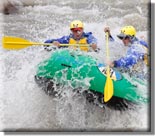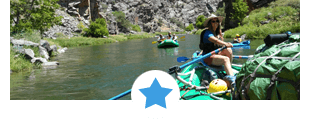What To Do When You Are Ejected From A White Water Raft
For some, it will be an unnerving feeling being ejected from the safety and warmth of your raft, and plunging into the cold and unforgiving rapids of a Colorado River. Though hopefully, you will remember the steps that need to be taken in order to make your rescue easier. They are not difficult, but are critical in ensuring your safety. Most likely you will be wearing a helmet and life vest as those are going to be your best friends on the river. You dont want to go anywhere without them. What follows here is a step by step guide on how to react when thrown from a raft, and into the torrents of a white water river.
Step 1: Stay Calm – A bad situation can only be made worse by letting your emotions get the better of you. If you find yourself in the water, it is going to be disorienting, loud, cold, and generally a terrifying thing if you are not used it. The best way it can be described is chaos… pure, unadulterated chaos. So if you are to follow the remainder of these steps, you must start at, and remain calm through till the end.
Step 2: Orientation – After being ejected from a raft while white water rafting, the first thing you are going to want to do is orient yourself. Begin by facing downstream, if you notice an approaching embankment you have a chance to get to, try and swim towards it. You will also want to take note of the location of the raft as they are going to try and pull you back in. They are going to do this either by holding out a paddle for you to grab, or throwing you a rope. So knowing which direction they will be coming from helps.
Step 3: Nose to Toes – After you gather your wits and orient yourself, you are going to want to face downstream and keep your toes and nose above the water. The reason for this is that you dont want to go down stream head first, as that implies if you were to hit a rock, it would be with your head first. You want your nose above water so you can breath. You want to keep your toes up for various reasons. One is that there are jagged and sharp rocks unseen to the eye under the water, you do not want to drag or hit your legs upon them. The second is that these rocks and other debris can snag you or your clothes and pull you under water. The third is that if you notice you are about to collide with a rock, your feet can soften the collision.
Step 4: Ride and Wait – Once you’ve gathered your wits, oriented yourself, and succeeded in nose to toes, all thats left is to wait for an opportunity to arrive where you can either be saved by the raft, or make a break for shore or an embankment. If the Raft is within distance, be sure to watch for any attempts on their parts to either throw you a rope or reach out with a paddle. If you notice an area suitable for landing, do not try to roll your body and swim downstream. Rather, roll your body so you face upstream, and swim to the side you wish to go. This will slow you down ensuring you dont overshoot the spot, but also keeps your head from pointing down river.
It may also be worthwhile to carry a whistle on your vest. Rivers are often loud, and if you manage to get ashore you do not want the raft to pass by you without knowing you made it as they will continue down, leaving you behind. The same can used if you get stuck or lodged in between rocks or trees and need to let them know as they approach.
If you would care to go Salt River Rafting or on a White Water Raft Trip, please contact Wilderness Aware Rafting to see what trips are available.


